 The
French received 274 M4A4s as Lend Lease. In addition, a small number, perhaps less than 50, former
British/Commonwealth M4A4s (Sherman Vs) were passed on to them in early
1945. Based on our study of the M4A4Ts, we suspect that the French must
have collected up more from European tank dumps in the post war years.
At the French Military Archives in Paris, Pierre-Olivier came across an entry in
the records of the 2ème Régiment de Hussards dated 13 September 1949,
"Lieutenant JEANNEST Louis of the 4th squadron detached for 3 months to the joint
commission set up for acceptance operations of M4A4 medium tanks from
Belgium, Ref D.M. N° 1635 EMG.FAG/ARMET dated 1.9.1949". P-O interprets this to mean that a joint
commission was established to receive or buy (accept) M4A4s from
Belgium. At present, P-O has not come across any statement of the
numbers involved. In any case, in order to accommodate the massive
30-cylinder Chrysler Multibank engine, the M4A4 was made 11 inches
longer than the standard Sherman. The Multibank with its front mounted
radiator (position 1) was so large that there was no room for vertical
fuel tanks in the front corners of the engine compartment, such as were
present on Radial engined M4s and M4A1s. However, the elongated hull
enabled the sponson fuel tanks (positions 2) to be enlarged to hold 80
gallons each. Thus, the two fuel tanks of the M4A4 held 160 gallons,
versus the 175-gallon capacity of the four fuel tanks on M4s and M4A1
Shermans. There might have been room for them, but the examination of a
few M4A4T wrecks suggests that no vertical fuel tanks were added, so
that the Transformés retained the M4A4's 160-gallon capacity. We would
note that the fuel tanks of M4s, M4A1s and M4A4s suffered in common from
an excessive heat condition, which caused melted solder joints and
other fire hazards. This was remedied by the addition of a pair grouser
compartment covers with air inlet grills (3) that provided for greater
air flow to the fuel tanks.
The
French received 274 M4A4s as Lend Lease. In addition, a small number, perhaps less than 50, former
British/Commonwealth M4A4s (Sherman Vs) were passed on to them in early
1945. Based on our study of the M4A4Ts, we suspect that the French must
have collected up more from European tank dumps in the post war years.
At the French Military Archives in Paris, Pierre-Olivier came across an entry in
the records of the 2ème Régiment de Hussards dated 13 September 1949,
"Lieutenant JEANNEST Louis of the 4th squadron detached for 3 months to the joint
commission set up for acceptance operations of M4A4 medium tanks from
Belgium, Ref D.M. N° 1635 EMG.FAG/ARMET dated 1.9.1949". P-O interprets this to mean that a joint
commission was established to receive or buy (accept) M4A4s from
Belgium. At present, P-O has not come across any statement of the
numbers involved. In any case, in order to accommodate the massive
30-cylinder Chrysler Multibank engine, the M4A4 was made 11 inches
longer than the standard Sherman. The Multibank with its front mounted
radiator (position 1) was so large that there was no room for vertical
fuel tanks in the front corners of the engine compartment, such as were
present on Radial engined M4s and M4A1s. However, the elongated hull
enabled the sponson fuel tanks (positions 2) to be enlarged to hold 80
gallons each. Thus, the two fuel tanks of the M4A4 held 160 gallons,
versus the 175-gallon capacity of the four fuel tanks on M4s and M4A1
Shermans. There might have been room for them, but the examination of a
few M4A4T wrecks suggests that no vertical fuel tanks were added, so
that the Transformés retained the M4A4's 160-gallon capacity. We would
note that the fuel tanks of M4s, M4A1s and M4A4s suffered in common from
an excessive heat condition, which caused melted solder joints and
other fire hazards. This was remedied by the addition of a pair grouser
compartment covers with air inlet grills (3) that provided for greater
air flow to the fuel tanks.


Aside from the interior ID plate,
some of the M4A4Ts examined have been noted to have "Rebuild" plates.
These have been seen welded to the tank's exterior. In some cases, they
have been found in three places on the same
tank - affixed to the front and rear of the hull, as well as on the top
of the turret. Of course in many instances, the plates have long since
rusted away or have been removed. The photo on the left shows what is
typically printed on one of these plates. The
right side photo shows the "usual" location of the front plate as noted
on M4A4 Serial Number 22169, a monument Sherman on display in Avranches
in Normandy. The plate's first line reads "A R L," which indicates that
the tank was "transformed" at the French
Army Facility known as "Atelier de construction de Rueil." Evidence found on the ARL plates suggests that the Transformé Program took place in the early 1950s.
We would note that other non M4A4T French Shermans have
been observed with rebuild plates or stampings from other facilities,
including
"A B S," (Atelier de construction de Bourges) and
"ERGMEB" (Etablissement de Réserve Générale du
Matériel - Engins Blindés).
A translation
of the plate above:
A R L (Atelier de construction de Rueil)
Char D57
(Thought to be the Serial Number of this particular M4A4T)
DATE 9.12.52 (9 December
1952, the date the M4A4T rebuild was accepted)


It is thought that the French Army stamped the
Ordnance Serial Number on most or all of the AFVs used in service in the
post war years. This has been recorded from quite a few surviving
Shermans tanks, to the extent that we refer to it informally as "the
Serial Number inside a box." This stamping is not always exactly in the
same place. Anyone wishing to see it is advised to look around on the
front of the tank. While the SN stamping is not exclusive to the M4A4Ts,
it has been noted on almost all surviving examples.


The photo on the left shows the typical M4A4 engine
deck configuration. The forward sections include an air intake grill
(1), and a cast armor blister (2) which protected the Multibank engine's
oversize radiator. The middle section of the deck (3) was hinged, and
could be lifted by means of a pair of handles in order to provide engine
access. The rear section (4) was not removable, but permanently welded
to the hull. The photo on the right shows the same view of an M4A4 after
the Transformé engine swap. As best we can tell, the conversion
retained the M4A4's middle engine deck plate (3), and simply replaced
the forward sections with the forward section of an M4/M4A1. The air
intake was protected by a large armored cover (5), and this in turn was
protected by a surrounding bullet splash (6).
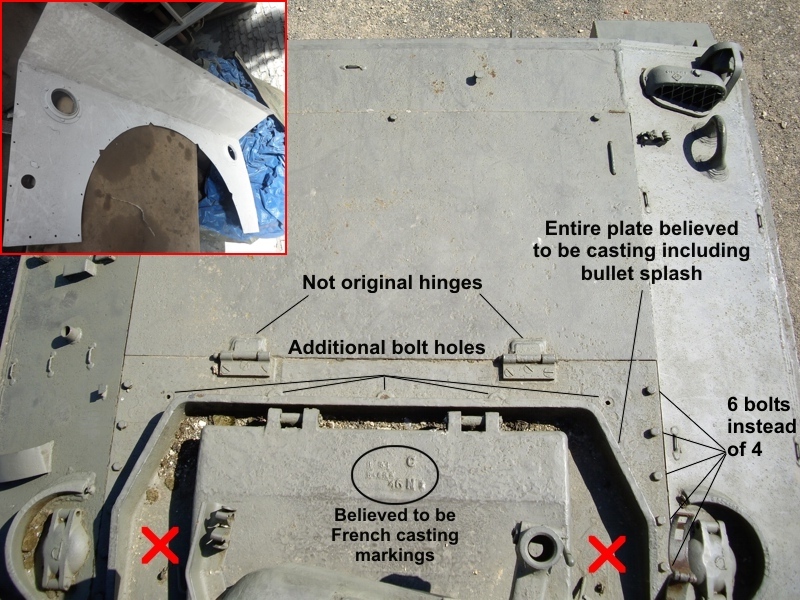
One might assume that the
M4A4T's forward engine deck section was salvaged from surplus or
obsolete M4s or M4A1s. That might have been the case on some, although
we have not as yet encountered such an example. The twelve surviving
M4A4Ts that we have seen that still have this section, are installed
with what appear to be aftermarket components that seem to have been
fabricated by a French firm specifically for the Transformé
program. From
personal examination we would judge that the entire "French" plate
is a casting that includes the bullet splash surround. In
contrast, the standard M4 or M4A1 forward engine deck section was an
armor
plate with the bullet splash welded on to it. The "French casting"
features five additional bolt holes directly behind the bullet splash. These
are NOT present on the standard US engine deck section. On 11 out of 12
examples examined so far, the "French" bullet splash is indented in
order to accommodate three of the bolts. The examination of a few survivors
reveals that these additional bolts held a baffle plate (inset) to the
underside of the forward engine deck. The armored air intake covers have
casting marks not seen on any of the same US produced intake covers we have
encountered. Like the standard 1944 US produced version of this plate, there
are no fuel filler locations on either side of the air intake opening (marked
by Xs). We have also noted that there are six bolts along the sponson edges, as opposed to four on
the standard US radial deck. Finally the hinges, with their slotted bolt heads are aftermarket parts,
as they are not original to M4, M4A1 or M4A4 Shermans.


The
photos above show the casting marks on two of the armored air intake covers. We would speculate that the name of the foundry that
cast these pieces might be represented by the letter "C,” possibly CAIL
(« Société
française de constructions mécaniques (SFCM), » also known as « Anciens
Établissements Cail ») the firm whose name is seen on the hull casting of the
Somua S-35. “No" might be for
"numéro," and pertain to the serial number of the individual casting
– thought to be 3 on the left and 161 on the right. The part number or
"numéro de pièce" would be the same on all of the castings, and looks
to have been "64688." For comparison, the part number of US WW II
produced intake covers is D51304, and has been seen cast on the underside, as
in the inset. The dates that the French parts were cast appear to be 1 51
(January 1951) and 3 52 (March 1952), and provide something of a clue regarding
the chronology of the Transformé program.

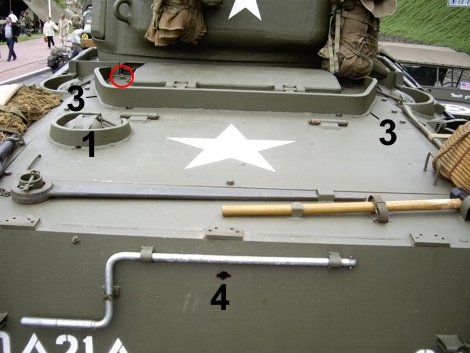
The above shows comparison shots of the reproduction radial engine deck
of an M4A4T on the left, and an original radial engine deck of an M4(105) on
the right. On first inspection these decks are almost identical in appearance,
although the Transformé’s replacement deck does NOT
include the additional engine oil filler cap (1) seen on Second Generation
M4s& M4A1s. As noted above, the major identifier that the M4A4T’s deck is
not a salvaged radial engine deck are the three indents (2) seen here, which
allowed the fitting of the additional bolts. In some cases, the indentations are very subtle,
and don’t show up in photos, but have been noted during “hands on” examinations.
We can
also see the welds attaching the bullet splash rail to the original deck (3),
these welds not being required on the Transformé’s one piece casting. Another difference is that
there are two bolts securing the forward edge on both sides of the air intake
in the US configured deck (we’ve circled in red one of the bolts). These bolts are not
present on any of the Transformé replacement decks we have examined. Also note the difference in
location of the engine crank holes (4).

It is thought that the French received a number of
replacement Continental R-975 engines as "Spare Parts" for the
approximately 1500 radial engined M4(105)s and M4A1(76)s that they were
issued as Mutual Defense Assistance in the early 1950s. These crated
engine kits appear to have included a number of additional items
including new instrument panels, air cleaners with all the necessary
piping and fittings, and the Barber-Colman type of exhaust deflectors.
The air cleaners (1) and the centrally mounted exhaust pipes (2) were
adapted to fit the M4A4 hull. Although we have not encountered any
surviving examples that still have it present, it is evident that the
exhaust deflector was installed as indicated by the fittings (3) that
secured it in the "down" position, as well as the fitting (4) which
secured it in the "up" position in order to provide access to the engine
doors (5).
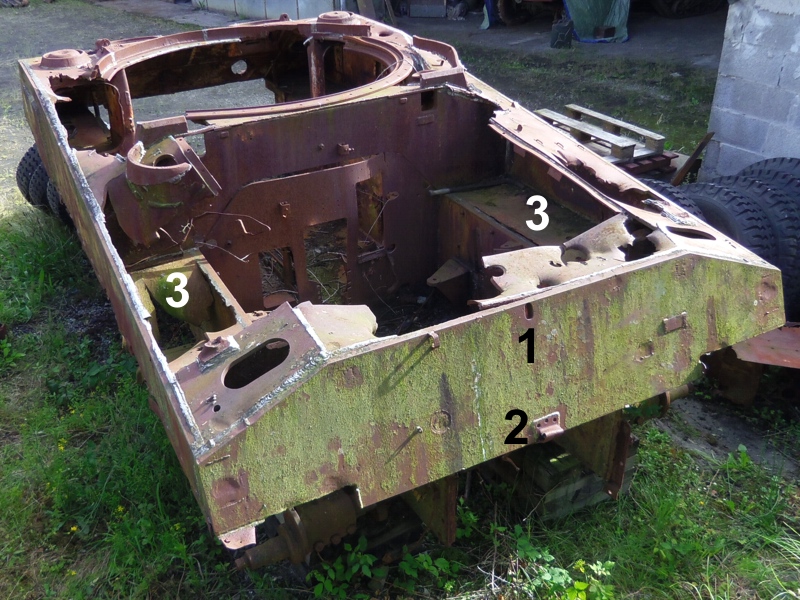
About a half dozen of the surviving M4A4Ts have been
recovered from Military Target Ranges. A few examples are very badly
damaged, and have been reduced to hulks, missing so much that a proper
ID is difficult. In the case shown above, the primary clue that this
was an M4A4T is the oblong engine crank hole (1) that was drilled or
ground into the top center of the M4A4’s upper rear hull plate. Only
Radial engine Shermans used a hand crank as part of the engine start up
procedure. On Radial airplanes, a crewman would spin the propeller a few
times so as to test for hydrostatic lock. On the radial Sherman, Step 1
of the start up procedure was, “Have engine turned over four complete
crankshaft revolutions by hand (about 50 turns of the hand crank).” This
would work to expel any excess fuel or oil that may have accumulated,
particularly in the combustion chambers of the cylinders closest to the
ground. A secondary M4A4T clue seen here is the fitting (2) that secured
the exhaust deflector in the "up" position. The two 80 gallon fuel
tanks of the M4A4 are missing from this hulk, but they sat on the
sponsons in the area indicated by the number 3.

Atelier
de construction de Rueil would have had to have provided a hand crank for each
M4A4T, either fabricated in house or salvaged from a surplus M4 or M4A1. The
photo above shows a restored example on display at Camp de Mourmelon in France.
The hand crank (1) seen here, along with the track wrench (2), do NOT reflect
the appearance of the same original equipment tools supplied in the US. It is
not known if the crank was made during the Transformé program, or fashioned in
later years for the display. We would note that the position of the hand crank
fittings corresponds to what has been observed on other M4A4Ts. Also of note
are the fittings with reflectors attached (3). These (or their weld scars) have
been observed on most or all surviving M4A4Ts, so it is thought that they were
added as part of the conversion process. This tank is Serial Number 4825. It
would have been accepted in August, 1942, and is at present the earliest
surviving M4A4 that we have recorded. It has the look of one of the 1610 M4A4s
remanufactured by Chrysler, and supplied to the British as Lend Lease in 1944. Despite
the fact that the French received 274 M4A4s as Lend Lease, a surprising number
of the surviving M4A4Ts are remanufactured, former British/Commonwealth
Shermans. We would assume that they were salvaged from post war Tank Dumps.

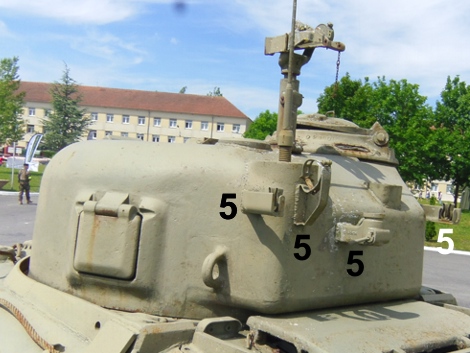
The commander's "split hatch" cupola was installed as
original equipment on all new production and remanufactured M4A4
Shermans. The study of surviving M4A4Ts suggests that it was replaced
with the "commander's vision cupola" (1) during the conversion process. The
transition to the improved cupola on new production Shermans was
completed in May, 1944. In addition, a Modification Work Order ((MWO
G104-W112) kit was released in September, 1944. It was to be retrofitted
to all "medium tanks of the M4 series located in overseas theaters of
operation or those scheduled for overseas shipment." These cupolas were
greatly superior to the old split hatches, and were in high demand in
combat zones. However, in the end, very few of the approximately 10000
kits produced were shipped overseas for field installation before the
end of WW II. About 1300 of the kits were retrofitted to Shermans
remanufactured in 1945. Thus, thousands of the kits would have been
available as "new old stock" after WW II, and it is thought that the
French received some as MDAP "Spare Parts" in the early 1950s. The kit
also included parts for an Anti-Aircraft Machine Gun Pintle Assembly
(2), and a vane sight (3 and inset) to replace the old blade sight (4).
Additionally, instructions were provided for relocating the commander’s
seat bracket, "to permit tank commander to look through vision blocks
while seated." One of the final instructions in the vision cupola
modification kit is "Install cal. .50 antiaircraft machine gun stowage
brackets (5) on back of turret in accordance with MWO G104-W108, if
vehicle is not so equipped." Thus, these two modifications were to be
installed together. It is thought that the French received some of the
MG stowage kits as well, since this mod is installed on many of the
turrets along with the commander's vision cupola.

From
start to finish, Chrysler M4A4s, including the 1610 units remanufactured from
December, 1943 though October, 1944, were built with a siren factory installed
on the left front fender as shown in the upper left. The siren most commonly
used on the M4A4 was the Federal Type 160 with the "V for victory"
grill (1). Power was supplied by conduit, and the coupling (2) is often all
that remains on many surviving Shermans. It is evident that the siren was
relocated with the M4A4T conversion, since surviving examples show the siren
mounted on a pad on the left front of the glacis plate just below the hull
lifting ring. The sirens are long since gone on most of the extant M4A4Ts, but
a mounting pad (3) remains. The presence of this pad on a surviving M4A4 is
almost invariably a clue of a Transformé conversion. A siren guard (4) was
fabricated, which on some hulls, is seen with wire mesh welded to its face. We
would note in passing that a few M4A4Ts and other French rebuilt Shermans have
a siren with stars around the faceplate (5).

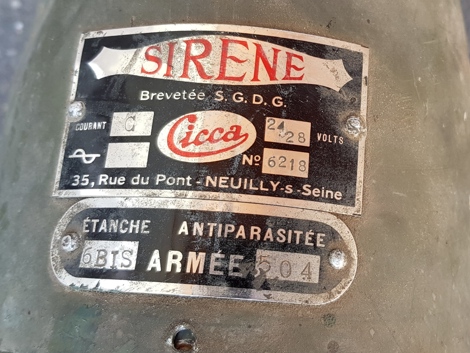
The
stars around the faceplate are not typical of any of the various US
produced sirens supplied to Sherman manufacturers. This siren was made
in France, probably during the late 1940s or early 1950s, by Cicca
(Compagnie Industrielle et Commerciale du Cycle et de
l’Automobile), an auto equipment and accessories manufacturer
based in Neuilly-sur-Seine, near Paris.

Non standard mudguards (or traces of them)
are seen on the rear of many of the M4A4Ts (1), so it is thought that they
were added as part of the Transformé conversion. This M4A4 is
Serial Number 21752, indicating that it was accepted in July,
1943. The “no pistol port turret” was introduced in
production at Chrysler in July, so the turret, if not the original, is
appropriate. This tank is on display as a monument in
Chavannes-le-Grand, France, and honors “Foch” an early 1943
production M4A4 of the 1er Régiment de Chasseurs d'Afrique,
5ème Division Blindée, that was knocked out there on
November 23, 1944.

The
French received large numbers of Armored Fighting Vehicles from the US as
Military Assistance in the early years of the 1950s. Almost 3000 Medium Tanks
were supplied. Aside from the close to 1500 Shermans mentioned earlier, 544 M26
Pershings and 854 "M46, M47, M48 Series" Pattons were reported to
have been shipped as of January 31, 1954. Given that, it is somewhat surprising
that the French would have needed to do the Transformé conversions at all, much
less obtain more M4A4s from British/Commonwealth post war surplus. Considering
that M4A4Ts represent a good number of the surviving M4A4s in France, we are
somewhat frustrated in not having been able to find any period photos of them
in French service. This leads us to suspect that they may have been intended
for “off the books” export to Israel in the tense years before the outbreak of
the Second Arab-Israeli war in October, 1956. It is obvious that the Israelis
procured a number of ex British and French M4A4s, and a few sources state that
some were Transformes. We can only observe that a small number of period
photos, such as the above, taken in September, 1954 during an IDF Training
Exercise in the Negev Desert, show what appear to be M4A4Ts with the
“indents” characteristic of a French made forward engine deck section. This tank can also be seen with the
exhaust deflector fitting (1). The surviving M4A4Ts in France (that have turrets) are
equipped with the commander's vision cupola (2), but none that we have examined
have retrofitted loader’s hatches (3) as seen on this example. So perhaps that
and the VVSS track holders (4) were added by the Israelis? We would observe in passing that, while Foch from the
preceding caption has a “no pistol port turret,” the turret on this
example has a welded up pistol port (5). The decision to eliminate the
pistol port in mid 1943 was universally
unpopular, and it was reinstated in production in late 1943, coincident
with the introduction of the loader’s hatch. A few surviving IDF Shermans actually have turrets
that were painstakingly retrofitted with pistol ports, such as the M50
turret shown in the inset.
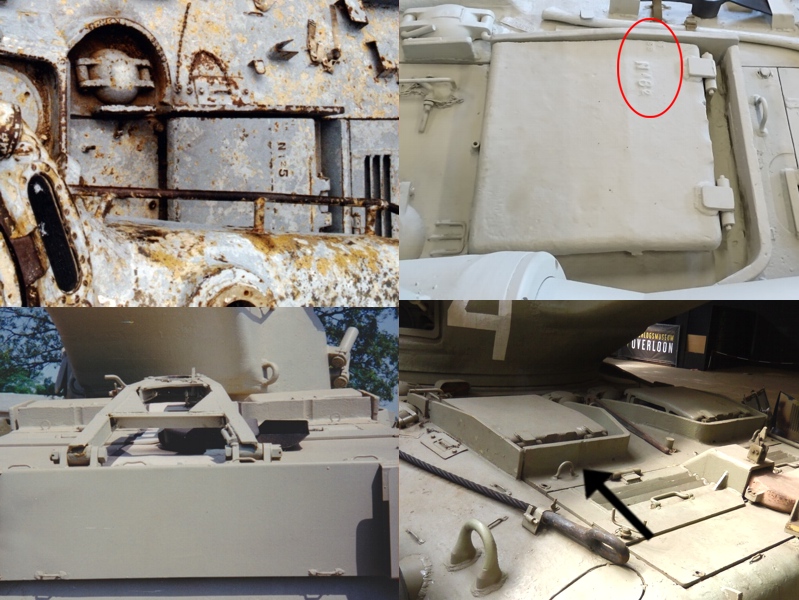
“First
Generation” Shermans with 75mm guns were still in combat use during the 1956
Sinai Campaign. It is thought that a number of these would have been M4A4Ts
with retrofitted loader’s hatches such as seen on the example in the previous
caption. None of these appear to have been preserved by the Israelis, possibly
because some or all were ultimately upgraded to the “legendary” M50
configuration. In
that regard, some French made M4A4T engine deck components appear to have been
recycled for reuse when Israeli Shermans were retrofitted with Cummins Diesel
Engines. On the top left is shown the French type casting marks on an armored
air intake cover half of an M4A4 based M50. On the bottom left are the “French
indentations” on the bullet splash halves on another M4A4 based M50. On the
right, we see both the indentations (arrow) and the French casting marks (circled in red) on an M4A1(76)
based M51. Of course, an M4A1 would have been built with the appropriate
forward engine deck components, but this example illustrates how original parts
were not necessarily reinstalled on their “mother” vehicles. Note that the
intake cover halves on the M50s on the left used only the original hinges, so
each half is attached with a single hinge. On the M51’s deck, the original
hinges can be seen to have been cut off, and two new hinges/fittings were added
to each half, perhaps for greater stability. Photos and info courtesy of Tom Gannon.
HOME


